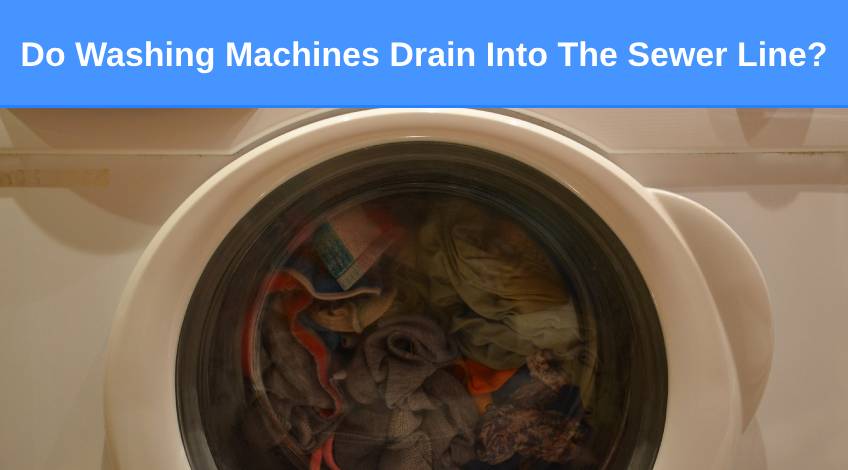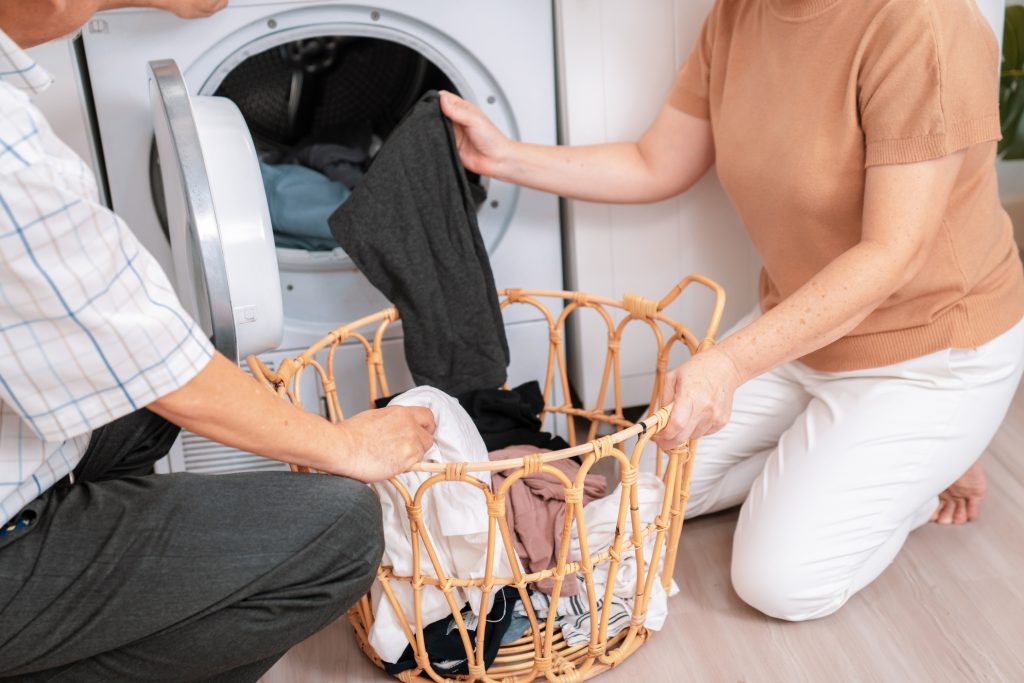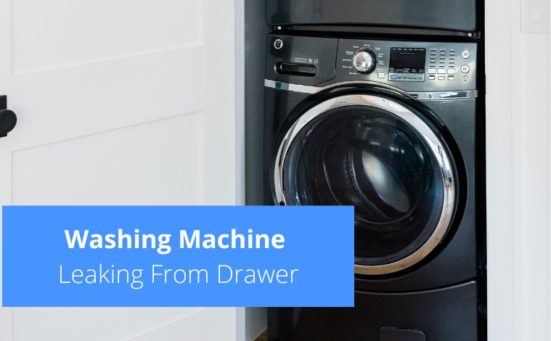
Do Washing Machines Drain Into The Sewer Line?
Unless you have a septic tank, your washing machine’s waste water should drain into the sewer line. If not, you are adding to the environmental damage of your local environment. This is because washing machines use chemicals that can pollute streams, rivers and oceans.
If that’s not bad enough, the water that’s pumped from your washer can also cause, or at least add to flash floods. This is because the waste water from your washing machine could overload the rainwater drainage system.
If you’re concerned that your washing machine’s waste water is not draining into the correct drainage system, keep reading. In this article we look at ways to identify the correct way to deal with the waste water from your washing machine.
What’s Wrong With Allowing Washing Machine Waste Water To Drain In The Rainwater Drain?
If you or anyone else has connected your washing machine’s waste water to the wrong system, it is not only contributing to the pollution of our waterways and seas. It is also illegal and you could face prosecution.
The problem is, you might be completely ignorant of this problem unless you check the pipe work. The pipes could have been fitted by a previous owner of your home, but unfortunately that’s no defence in the eyes of the law.
The current owner is responsible according to British law which means it’s down to you to correct this issue. If you don’t own the property, contact your landlord and make them aware of this problem.
Where Does Your Washing Machine’s Waste Water Go?
In the average UK home, there are two different drainage systems.
- One takes all of the waste water from the home including sinks, washing machines, dishwashers, baths, showers and toilets. This waste water eventually links up with your area’s main sewer pipe and is directed to a water treatment plant where it is treated to remove any harmful chemicals before being discharged back into the water course.
- The other is connected to storm drains and collects rainwater running from the roof of your home. This water is discharged directly into rivers and streams without being treated.
As you can see, they both have different jobs and the water is sent to two very different locations. These two systems should never be mixed up.
If all of the rainwater that fell from every roof in your town or village went into the sewerage system, the system wouldn’t be able to cope with it. This would cause many problems which could eventually lead to an environmental disaster.
Likewise if all of the waste water produced in your home was to get into the drain that runs directly to the rivers etc, it would very soon pollute those waterways which would also be an environmental disaster.
If connected to the wrong system, your household’s waste water could be pumping harmful and damaging chemicals into local rivers and streams. Or it could be adding to the overloading of storm drains during heavy rainfall which could cause a flash flood.
How To Tell Where Your Washers Waste Water Goes

It’s easy to identify the storm drain that your home is connected to, it’s the one that the down pipe from your guttering is connected to. When it rains, the water runs from your roof and is directed along the gutter towards a down pipe.
That down pipe discharges into a drain sunk into the floor. That drain is your storm drain and connects directly to the surface water drainage system which runs under the roads and eventually runs to an outlet pipe into a local river.
If there is a small pipe coming through the wall of your home which also drains into that same drain, it’s most likely the waste pipe from an appliance. Either a dishwasher or washing machine and is illegally discharging pollutants into the storm drainage system.
This could be causing untold damage to local aquatic life and needs to be resolved as soon as possible.
Where Should The Washing Machine Waste Pipe Be Connected?
Look at the outside of your house, you should see a large, 4 inch stack pipe (it’s the one connected to the toilet). All of your sinks, baths, showers and appliances like dishwashers and washing machines should be connected to this 4 inch stack pipe.
The stack pipe shouldn’t have any connections to any down pipes from the gutter; these should be running to a separate drain. The stack pipe typically disappears underground and runs directly to the main sewer line. Where the waste water is sent to a treatment plant and treated before being discharged back into the water course.
What About Properties Not Connected To The Main Sewer Line?
There are some properties that are not connected to the main sewer line. These properties have what’s known as a septic tank which stores all of their waste water.
All of the waste water from their home including water from sinks, baths, showers, as well as washing machines and dishwashers is transferred via a waste pipe and stored in a large container typically situated underground (but not always).
This septic tank will need to be emptied on occasion which is done using a tanker with a large suction hose. The tanker driver will insert the hose into your septic tank and all of the waste water and effluent will be sucked into the large tanker, emptying your septic tank.
This task is typically needed once a year to ensure there are no problems with your home’s wastewater collection. However, you may need yours emptied more often depending on the size of the tank and how much wastewater your home produces.
Is There An Eco Friendly Option?

If you are trying to set up a permaculture home, you might not want to waste all of the water from your washing machine. You might want to use it to water your crops for example.
It’s generally accepted that only “grey water” can be used for watering plants etc.
What Is Grey Water?
Grey water is basically waste water from your home that is free from harmful chemicals and pathogens. In other words, it’s water that won’t damage your plants or the environment. This is different to the waste produced in your toilet (which is known as black water).
To successfully use grey water on your crops you will usually need to install a pond with natural filtering to remove any detergents etc from the water before it can be used to water your plants.
The siting of this pond should be far enough away from your home to not be a flood risk if it overflows and should not have the ability to encroach on your neighbours land.
What Substances In The Water Change It From Grey To Black Water?
If you are considering using your grey water to eventually water your plants, there are a few things you need to consider. There are certain substances that change the water from grey to black. These include;
- Faeces
If you use terry nappies for example without a liner, the wastewater will contain faeces which changes the water from grey water to black water. - Detergents Containing Sodium
Not all the detergents available are detrimental to the environment. However, you should keep away from any sodium based detergents. Sodium is poisonous to plant life. - Bleach
Bleach is not only harmful to plants, it also harms microbiotic life in the soil. If you have used bleach in your washer, don’t allow the water to discharge into your grey water supply.
Why Does My Sewer Get Blocked Every Time The Washing Machine Is Used?
If your washing machine is connected to the main sewer line and it keeps getting blocked, there are several things that could cause this. Which include;
- The Waste Pipe Is Blocked
The waste pipe that leads from the washing machine’s drain hose to the main sewer line could be blocked. - The Washing Machine Shares The Same Drain As Another Outlet
If your washing machine waste water hose shares the same pipe as the sink for example, using them both at the same time could be causing the problem.
You will need to get all of the above checked out by a professional to solve these issues.
SEE ALSO: Clothes Come Out Of Washing Machine Smelling? (here’s why & what to do)
Frequently Asked Questions
Washing machine water should drain either into a nearby sink or into a standpipe that connects to the main sewer line.
The washing machine drain pipe should lead to the standpipe which leads to the main sewer line and then onto a treatment plant.
If your sewer backs up when you use your washing machine it is typically caused by a blockage in the drainage pipe. This should be dealt with by an expert and should not be tackled with chemicals as these can damage the pipes.
The waste water from your washing machine should drain into the main sewer line and not the rainwater drain. To differentiate between the two, the rainwater drain has a downpipe that’s connected to the gutter.
In the UK all household or business waste water travels through the sewer lines to the water treatment plant.




